Pilots from the Wisconsin Air National Guard's 115th Fighter
Wing in Madison, recently honed their air-to-air combat training
skills along side their naval counterparts from the Strike Fighter
Squadron 2 (VFA-2), Naval Air Station Lemoore, Calif., during a
two-week training mission. Air Guard pilots from the 176th Fighter
Squadron put their F-16C Fighting Falcons to the test against
FA-18F Super Hornets from the active-duty Navy squadron. The
training missions featured air-to-air and air-to-ground offensive
and defensive combat tactics designed to simulate real-world
operations.
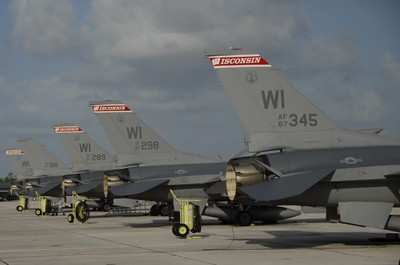
For nearly a week, more than 140 active duty naval airmen,
pilots and support personnel shared a large hangar with 120
guardsmen from the 115th FW to support eight missions a day.
"This is the culmination of our air-to-air training," said Lt.
Col. Erik Peterson, 176th FS commander. "We typically only do this
exercise once every year and a half and this allows us to simulate
probably the most challenging scenarios we can." Most of the combat
flying-skills training is done back at the home station, however,
the Key West air space is a unique environment that offers the
ability to do things they would not normally be able to do at
home.
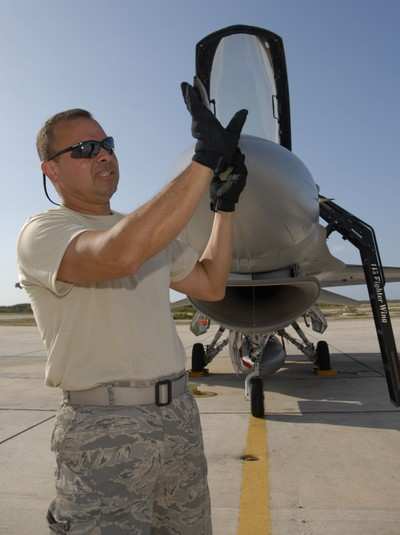
"Over the water here, we can go supersonic speeds at all
altitudes up to 50,000 feet and that is typically hard to do with
certain airspace limitations over land," said Colonel Peterson. The
available airspace for military training in and around Key West is
more than 134,000 square miles that essentially is free of
commercial air traffic.
"Warfare today often relies upon being able to operate in a
joint and coalition environment, so every event that can reinforce
those skills makes us an even better defensive force," said Navy
Capt. Steve Holmes, NAS Key West commander. "Collectively, that is
what makes NAS Key West the premier air-to-air training base in the
Navy." The daily missions that pitted the Air Guard and Naval
aircraft had each assuming a 'red' adversary or 'blue' defensive
role depending on the scenario given. Each pilot flew at least one
mission as either of these roles.
"The F-16C provides simulation for us that, in some aspects, we
can't do with the FA-18F itself," said Navy Lt. Richard Lang, VFA-2
detachment officer-in-charge. "We get a tremendous amount of
experience and exposure by seeing a different type of aircraft and
just fighting something different than you do on a normal everyday
basis." Watching the action from a dark room with large screens
that would make video game enthusiasts jealous are pilots from both
services. Inside the tactical air control facility, real-time
interaction, as transmitted from equipment on the aircraft, is
viewed, recorded and evaluated which translates into a scorecard of
how aircrews in each unit performed their scenario.
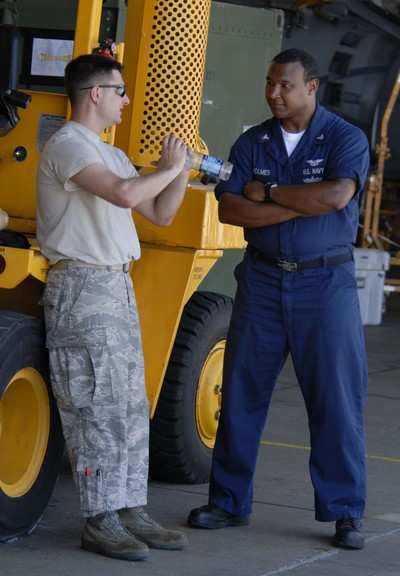
In addition to the air-to-air combat training, the aircraft
maintenance crews and administrative support people worked the
exercise as if they were in a real-world deployed environment. As
part of the exposure to a multi-service operation, the aircraft
maintainers participated in a swap program that had Air Guard crew
chiefs helping launch the FA-18s and Navy plane captains doing the
same with the F-16Cs.
"If we see something that they are doing that is a great idea we
can bring it into our training and make us a better team," said
Master Chief Petty Officer John Cloyes, VFA-2 maintenance master
chief. The hangar facility where the units are housed during the
exercises allows for all of the operations, maintenance and support
elements to be co-located. This provides for maximum collaboration
amongst all participants, both Colonel Peterson and Lieutenant Lang
said.
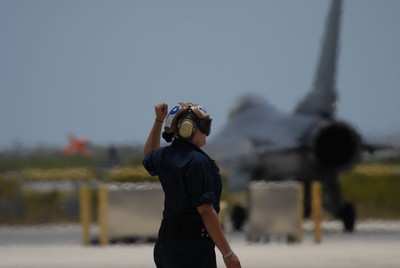
Not only is everyone working in close proximity, they are all
housed near each other as well. Off-duty time often requires
carefully choreographed car pools for those who want to go
downtown.
"We are all within a one-block area of each other and in the
evening you see folks out walking around that you would not
normally see if you were at home," said Maj. Matt Eakins, 115th FW
maintenance operations officer. "Here we get the camaraderie of
having to share a ride everywhere you go." Flying and maintaining
the aircraft are essentially only two-thirds of the complete
mission, said Senior Master Sgt. Steve Veers, 115th Aircraft
Maintenance Squadron first sergeant. Lodging, food, transportation,
military pay and communication are just a few of the essential
services that support personnel provide, he said.
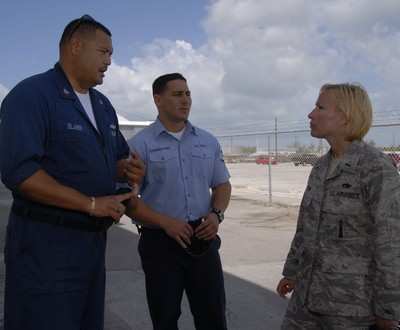
"We want to take care of all of the little problems so they can
focus on fixing and flying the jets," said Chief Petty Officer Mike
Grange, VFA-2 administrative chief. "It is our job to make sure
that everything goes smooth." [ANN Salutes Tech. Sgt. Don Nelson,
115th Fighter Wing Public Affairs]
 Aero-News: Quote of the Day (12.09.25)
Aero-News: Quote of the Day (12.09.25) ANN's Daily Aero-Term (12.09.25): High Speed Taxiway
ANN's Daily Aero-Term (12.09.25): High Speed Taxiway ANN's Daily Aero-Linx (12.09.25)
ANN's Daily Aero-Linx (12.09.25) NTSB Final Report: Diamond Aircraft Ind Inc DA20C1 (A1); Robinson Helicopter R44
NTSB Final Report: Diamond Aircraft Ind Inc DA20C1 (A1); Robinson Helicopter R44 ANN FAQ: Q&A 101
ANN FAQ: Q&A 101







